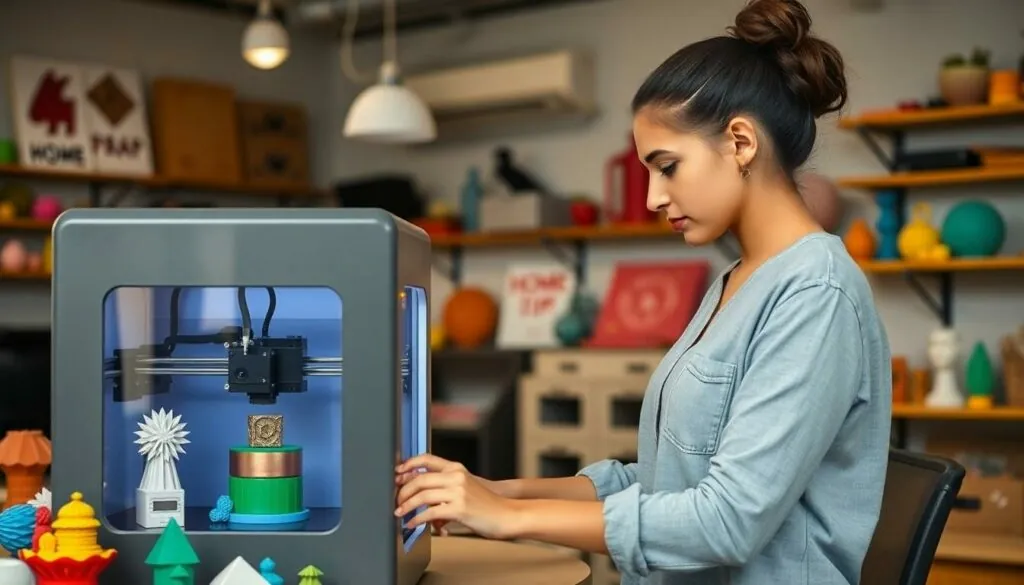Table of Contents
ToggleIn a world where everything seems to be made of plastic and dreams, 3D printing stands out as a magical tool that turns imagination into reality. Whether it’s creating quirky gadgets or personalized gifts, the possibilities are endless. But why just print for fun when you can cash in on your creativity?
Popular 3D Printing Products
3D printing offers a range of products that appeal to various markets. Creators can tap into popular trends by producing unique items in demand.
Home Decor Items
Decorative pieces created through 3D printing are both innovative and customizable. Shelves, vases, and lampshades showcase intricate designs, enhancing any room’s aesthetic. Wall art that features geometric shapes or personalized prints attracts customers seeking uniqueness. Planters with self-watering mechanisms appeal to plant lovers. Mixing materials allows for visually striking combinations, expanding options for buyers.
Personalized Gifts
The demand for personalized gifts continues to rise. Customizable items such as keychains, nameplates, or photo frames provide heartfelt options for special occasions. Each piece can include names, messages, or specific designs that reflect personal connections. 3D-printed jewelry, such as rings or bracelets, offers a unique touch to gifts. Novelty items, including customized trophies or medal holders, resonate well in celebration contexts.
Niche Market Opportunities

Exploring niche markets can reveal lucrative avenues for 3D printing ventures. Specific industries and areas show increasing demand for innovative 3D-printed products.
Prototyping Services
Prototyping services play a vital role in various sectors, including engineering and product design. Designers rely on 3D printing to create accurate prototypes quickly. Rapid iteration minimizes production time and costs significantly. Small businesses benefit from affordable prototyping options that allow testing without large investments. Customized prototype designs meet targeted requirements, providing a competitive edge. Offering 3D printing services to other businesses can attract clients from different industries seeking efficiency.
3D Printed Jewelry
3D printed jewelry caters to consumers wanting unique accessories. This market thrives on personalization, allowing customers to create bespoke pieces reflective of their style. Designers utilize 3D printing to craft intricate designs that traditional methods struggle to achieve. Diverse materials, such as metals and plastics, enhance the product range available to buyers. Boutique creators often find success by targeting niche audiences with specific styles or themes. This approach fosters customer loyalty through exclusive collections and custom options.
Starting Your 3D Printing Business
Starting a 3D printing business requires thoughtful planning and execution. Entrepreneurs must consider various factors, from equipment choices to online store setup.
Choosing The Right Equipment
Selecting appropriate equipment stands as a critical first step. Consider investing in a reliable 3D printer that fits budget constraints, such as FDM or SLA models. Evaluate each printer’s specifications, like print volume and resolution, to ensure it meets project requirements. Some popular brands, including Prusa and Anycubic, deliver quality and performance. Alongside hardware, necessary accessories such as filament and software bring projects to life. Researching and understanding materials is vital as diverse options like PLA and ABS cater to different applications. Owning the right tools significantly impacts production efficiency and product quality.
Setting Up An Online Store
Setting up an online store represents a crucial component of a successful 3D printing business. Platforms like Etsy or Shopify offer intuitive options for sellers. Establishing a user-friendly interface attracts potential customers, making navigation easy. Product descriptions must be clear and engaging, showcasing unique features and benefits. High-quality images effectively illustrate designs and foster buyer interest. Optimizing store visibility through SEO strategies enhances searchability for targeted audiences. Promoting products through social media channels generates buzz and drives traffic to the store. A well-structured online presence lays the foundation for generating sales and expanding the customer base.
Marketing Your 3D Printed Products
Effective marketing strategies enhance the appeal of 3D printed products. Utilize social media platforms like Instagram and Facebook to showcase designs. Engaging photos capture attention and encourage potential buyers. Create targeted ads to reach specific demographics interested in customizable home decor or personalized gifts.
Building an online presence establishes credibility. Crafting a well-designed website with an easy-to-navigate interface promotes user engagement. Including product descriptions that highlight unique features informs and excites customers. Implementing SEO techniques boosts visibility in search engine results, reaching a broader audience.
Participating in local markets or craft fairs offers direct consumer interaction. Displaying samples allows customers to see the quality firsthand. Word-of-mouth marketing from satisfied customers builds trust and encourages repeat business. Networking with other local artisans or businesses can enhance visibility through collaborations.
Email marketing serves as an effective tool for customer retention. Sending regular newsletters featuring new products, special offers, or seasonal promotions keeps the brand top-of-mind. Encouraging customers to share their experiences on social media cultivates a community around the brand.
Reviews and testimonials play a critical role in influencing purchasing decisions. Highlighting positive feedback on product pages provides social proof. Prompting satisfied customers to leave reviews after purchase fosters trust and credibility. Engaging with customer feedback demonstrates commitment to product quality and customer satisfaction.
Experimenting with limited-time offers or exclusive collections can generate urgency. Scarcity tactics motivate potential buyers to act quickly. Hosting giveaways or contests encourages interaction while expanding reach. Marketing 3D printed products effectively combines strategic initiatives, cultivating a loyal customer base and driving sales growth.
The potential of 3D printing for entrepreneurship is immense. By tapping into unique ideas and trends, creators can carve out profitable niches in the market. The ability to offer personalized products sets them apart in a competitive landscape. With the right strategies in place for marketing and customer engagement, success is within reach.
As the technology continues to evolve, so do the opportunities for innovation. Whether it’s through bespoke jewelry or custom home decor, 3D printing allows for endless creativity. Embracing this transformative tool not only fulfills artistic passions but also opens doors to a thriving business.

